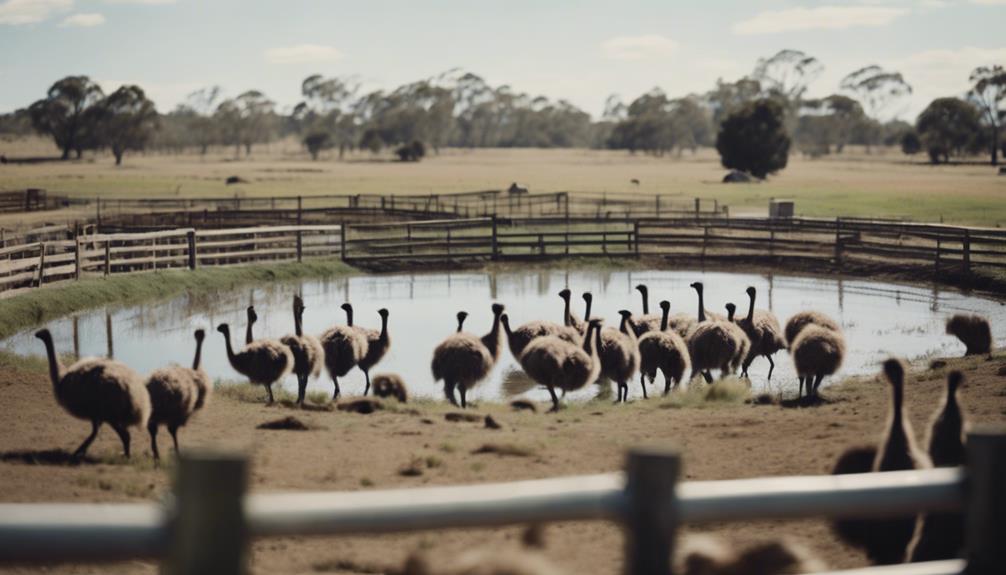
Did you know that emu farming has been on the rise, with the global emu oil market expected to reach over $132 million by 2026?
The environmental impact of this industry, however, is a complex issue that requires careful consideration. From land degradation to wildlife interactions, emu farming touches on various aspects of our ecosystem.
Understanding the implications of this practice is crucial for making informed decisions about our agricultural and environmental future.
Key Takeaways
- Sustainable grazing practices are crucial for mitigating land degradation in emu farming.
- Efficient water management is essential to reduce the environmental impact of emu farming.
- Strategies to reduce greenhouse gas emissions and optimize waste management are vital in emu farming.
- Conservation efforts and sustainable practices are key to minimizing the environmental footprint of emu farming.
Land Degradation
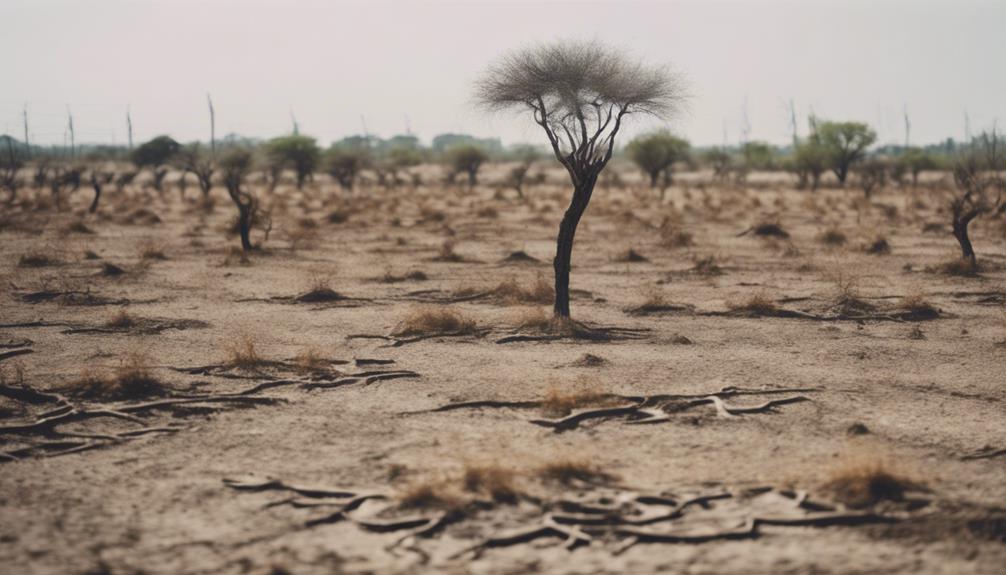
Land degradation caused by emu farming results in significant changes to the quality and productivity of the soil. Soil fertility, crucial for sustaining crop growth and biodiversity, can be severely impacted due to emu farming practices. Erosion prevention becomes challenging as the land may become more susceptible to soil erosion, especially in areas where grazing management isn't effectively implemented.
Grazing management plays a pivotal role in mitigating land degradation. Properly managed grazing practices can help maintain soil health and structure, preventing erosion and preserving soil fertility. Sustainable practices such as rotational grazing can aid in distributing the impact of emu farming on the land more evenly, reducing the risk of degradation in specific areas.
To address the issue of land degradation effectively, it's essential for emu farmers to prioritize sustainable grazing management practices. By implementing careful strategies to manage grazing areas and maintain soil health, the long-term impact of emu farming on land degradation can be minimized, ensuring the preservation of soil fertility for future generations.
Water Usage
The management of water usage in emu farming is a critical aspect that warrants attention to ensure sustainable practices and minimize environmental impact. Sustainable water management practices such as irrigation efficiency and conservation are key to reducing water wastage and preserving this vital resource. By implementing efficient irrigation techniques, emu farmers can optimize water usage, leading to both environmental and economic benefits.
To highlight the importance of sustainable water management in emu farming, consider the following comparison table:
| Irrigation Technique | Water Usage Efficiency |
|---|---|
| Drip Irrigation | High |
| Sprinkler Irrigation | Moderate |
| Flood Irrigation | Low |
| Subsurface Irrigation | High |
| Center Pivot Irrigation | Moderate |
The table demonstrates varying levels of water usage efficiency associated with different irrigation methods. Embracing practices that prioritize water conservation and efficiency can significantly reduce the environmental footprint of emu farming operations, ensuring responsible water stewardship for future generations.
Greenhouse Gas Emissions
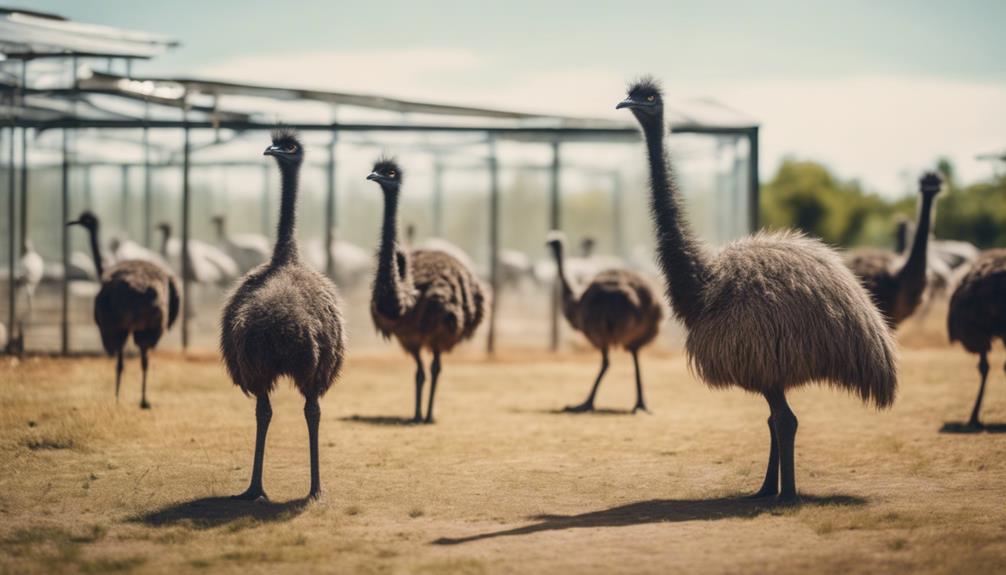
Analyzing the emission levels of greenhouse gases from emu farming operations reveals significant insights into the environmental impact of this agricultural activity. Emu farming contributes to greenhouse gas emissions primarily through methane released by emus during digestion and manure decomposition. Methane, a potent greenhouse gas, has a significant impact on global warming.
To address this, implementing emission reduction strategies is crucial. These strategies may include optimizing feed formulations to reduce methane production in emus, implementing efficient manure management practices, and utilizing renewable energy sources on farms to decrease overall emissions. Additionally, emu farmers can consider participating in carbon offsetting initiatives to balance out their greenhouse gas emissions.
Waste Disposal
To effectively manage waste in emu farming operations, optimizing disposal methods is crucial for minimizing environmental impact. Recycling initiatives play a significant role in reducing the environmental footprint of emu farming. By implementing comprehensive recycling programs, such as reusing materials like packaging or converting waste into new products, farms can significantly decrease the amount of waste sent to landfills.
Composting methods also offer a sustainable solution for managing organic waste on emu farms. Through composting, organic materials like manure and leftover feed can be transformed into nutrient-rich soil amendments, reducing the need for chemical fertilizers and promoting soil health.
Efficient waste disposal practices not only benefit the environment but also contribute to the overall sustainability of emu farming operations. By incorporating recycling initiatives and composting methods into daily practices, emu farms can minimize their ecological impact while creating a more circular and resource-efficient system. Embracing these waste management strategies is essential for ensuring the long-term viability of emu farming in a way that's environmentally responsible and economically sound.
Biodiversity Impact

Considering the biodiversity impact of emu farming requires a comprehensive evaluation of its interaction with local ecosystems and wildlife populations. Emu farming can have significant consequences on biodiversity, affecting various aspects of the environment. Here are some key points to consider:
- Habitat Destruction: Emu farming may lead to habitat destruction as natural ecosystems are cleared to make way for farms. This can result in the displacement of native species, disrupting the delicate balance of the local flora and fauna.
- Species Displacement: The presence of emu farms can lead to the displacement of native species from their natural habitats. This displacement can have cascading effects on the entire ecosystem, potentially leading to a decline in biodiversity and the loss of important species.
- Ecosystem Disruption and Genetic Diversity: Emu farming can disrupt local ecosystems by altering food chains, nutrient cycles, and species interactions. This disruption can impact genetic diversity within populations, potentially reducing resilience to environmental changes and threatening the overall health of the ecosystem.
Energy Consumption
Emu farming operations consume a significant amount of energy in various stages of production and maintenance. To mitigate this impact, incorporating renewable resources and efficiency measures can significantly reduce the overall energy consumption.
Implementing solar panels to power heating, cooling, and lighting systems can harness renewable energy sources. Additionally, optimizing feed formulation processes can enhance energy efficiency by reducing wastage and improving the feeding conversion ratio.
Advancements in alternative energy and technology offer promising solutions. Integrating wind turbines or bioenergy systems into the farming infrastructure can supplement energy needs sustainably. Moreover, adopting energy-efficient equipment and automated systems can streamline operations while conserving energy. Regular maintenance of machinery and facilities is also crucial to ensure optimal performance and minimize energy wastage.
Chemical Usage
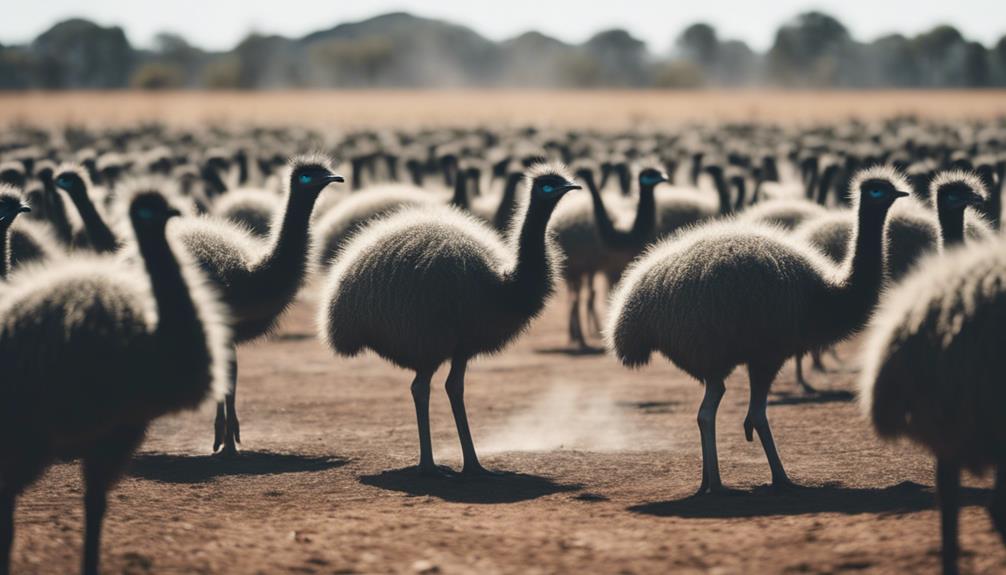
Given the significant energy consumption implications of emu farming operations, the evaluation of chemical usage becomes paramount in assessing the overall environmental impact of the industry. When it comes to chemical usage in emu farming, there are several key considerations to keep in mind:
- Reducing Pesticides: Emu farmers can explore integrated pest management strategies to minimize the use of pesticides. By employing techniques such as crop rotation and introducing beneficial insects, the reliance on chemical pesticides can be reduced significantly.
- Organic Alternatives: Embracing organic farming practices can be beneficial for both the environment and the emus themselves. Utilizing organic fertilizers and pesticides can help maintain soil health and biodiversity while also reducing the overall chemical load on the farm.
- Precision Application: Implementing precision agriculture techniques can ensure that chemicals are applied only where and when needed, reducing wastage and minimizing environmental impact. By using technology like GPS-guided equipment, emu farmers can target specific areas, optimizing chemical usage efficiency.
Soil Erosion
Soil erosion poses a significant challenge in the context of emu farming operations due to its potential impact on land sustainability and productivity. Erosion control methods are crucial in mitigating this issue. Implementing conservation techniques can help maintain soil health and prevent erosion. By incorporating practices such as contour plowing, terracing, cover cropping, and no-till farming, emu farmers can reduce the risk of soil erosion on their land.
Contour plowing involves plowing across slopes instead of up and down, which helps to slow water runoff and prevent soil from being carried away. Terracing, creating level areas on slopes, reduces the speed of water flow, allowing it to infiltrate the soil. Cover cropping involves planting vegetation to protect the soil surface from erosion. No-till farming minimizes soil disturbance, preserving its structure and reducing erosion.
Emu farmers must prioritize the implementation of these agricultural practices to safeguard soil health and maintain the sustainability of their land for future generations.
Deforestation

To understand the full scope of environmental impact associated with emu farming, one must examine the issue of deforestation and its implications on land use and biodiversity.
Deforestation due to emu farming results in:
- Habitat loss, wildlife displacement: The clearing of forests to make way for emu farming leads to the destruction of natural habitats for various wildlife species. This habitat loss can displace animals, disrupt their natural behaviors, and push them towards extinction.
- Resource depletion, ecosystem disruption: Deforestation for emu farming depletes essential resources like water, soil nutrients, and vegetation. This disruption in the ecosystem affects the delicate balance of flora and fauna, causing long-term consequences on biodiversity and overall ecosystem health.
- Soil degradation, erosion: The removal of trees and vegetation for emu farming exposes the soil to erosion risks. Without the protective cover of plants, soil erosion accelerates, leading to decreased soil fertility, compromised water quality, and increased vulnerability to natural disasters like landslides.
Wildlife Interactions
How do wildlife populations interact with emu farming practices in terms of habitat utilization and species coexistence? Emu farming can impact wildlife interactions in various ways. One key aspect is habitat preservation. Emus require large areas of land for grazing and nesting, which can lead to habitat loss for other wildlife species. This competition for space can potentially displace native animals and disrupt their natural behaviors.
Moreover, predator-prey dynamics come into play. Emus are preyed upon by various predators like foxes and feral dogs. The presence of emu farms can attract these predators, creating imbalances in local ecosystems. This can result in increased predation pressure on both emus and other wildlife species.
To mitigate these impacts, proper management strategies are essential. Implementing measures to protect natural habitats, such as leaving buffer zones between emu farms and wildlife reserves, can help reduce conflicts. Additionally, controlling predator populations around emu farms can aid in maintaining a balance in predator-prey dynamics, benefiting both emus and native wildlife.
Carbon Footprint
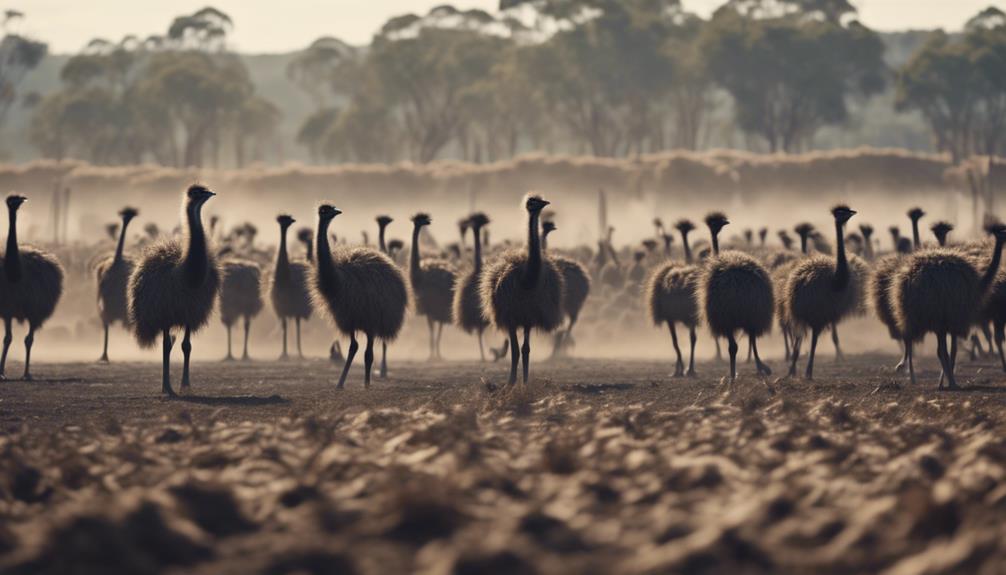
Emu farming practices contribute to the carbon footprint through various avenues, highlighting the environmental impact of this industry beyond wildlife interactions. The carbon footprint of emu farming is influenced by several factors such as feed production, transportation, and waste management. Here's how these factors impact the carbon footprint of emu farming:
- Feed Production: The cultivation of feed crops for emus often involves the use of chemical fertilizers and intensive farming practices that emit greenhouse gases. Opting for sustainable practices like organic feed production can help reduce the carbon footprint associated with feed cultivation.
- Transportation: The transportation of emus and their products to markets results in carbon emissions. Utilizing renewable energy sources for transportation and implementing efficient logistics can lower the carbon footprint of this aspect of emu farming.
- Waste Management: Proper waste management techniques, such as composting manure to reduce methane emissions, and carbon offsetting initiatives can play a crucial role in mitigating the environmental impact of emu farming. Implementing conservation efforts on emu farms can also contribute to reducing the carbon footprint of the industry.
Sustainable Practices
Amid growing concerns about environmental sustainability, implementing efficient practices in emu farming becomes paramount. Embracing eco-friendly methods and utilizing renewable resources are key aspects of sustainable emu farming. By incorporating ethical sourcing and conservation efforts, emu farms can minimize their impact on the environment while meeting the demands of the market.
| Sustainable Practices | Description | Benefits |
|---|---|---|
| Eco-Friendly Methods | Implementing practices that are environmentally friendly, such as using organic feed and natural fertilizers. | Reduces pollution and promotes ecosystem health. |
| Renewable Resources | Utilizing resources that can be naturally replenished, like solar power for heating and wind energy for electricity. | Decreases reliance on non-renewable sources, lowering carbon footprint. |
| Ethical Sourcing | Ensuring that emus are treated humanely and ethically throughout their lives, from breeding to harvesting. | Promotes animal welfare and consumer trust. |
| Conservation Efforts | Engaging in initiatives to protect natural habitats, preserve biodiversity, and support wildlife conservation. | Helps maintain ecological balance and biodiversity. |
Frequently Asked Questions
How Do Emu Farms Affect Local Economies and Communities?
Emu farms impact local economies by fostering economic development through job creation and product sales. They strengthen community relationships by providing opportunities for engagement and collaboration, contributing to the fabric of neighborhoods and towns.
Are There Any Health Risks Associated With Consuming Emu Products?
When you consider the nutritional benefits and safety of consuming emu products, you'll find that they align with modern consumer preferences and trends. Emu meat offers a lean, protein-rich option that's gaining popularity.
What Regulations and Standards Are in Place to Monitor and Regulate Emu Farming Practices?
To ensure regulatory compliance and promote environmental sustainability in emu farming, monitoring practices are in place. These standards oversee aspects like land use, waste management, and animal welfare. By adhering to these regulations, farms can operate responsibly.
How Do Emu Farms Impact Indigenous Land Rights and Traditional Practices?
When it comes to land ownership and cultural preservation, emu farms can impact indigenous communities. It's vital to consider how these practices intersect with traditional land rights and heritage preservation efforts.
What Are the Social Implications of Emu Farming on Workers and Labor Conditions?
In emu farming, worker rights and labor conditions play a crucial role. Ensuring fair treatment, safe environments, and just wages for workers is essential. Improving labor conditions fosters a sustainable and ethical industry.
Conclusion
In conclusion, emu farming has a significant environmental impact, including land degradation, water usage, and greenhouse gas emissions. Like a puzzle missing a piece, the biodiversity and wildlife interactions suffer from this industry.
However, implementing sustainable practices can help reduce the carbon footprint and mitigate these negative effects. It's crucial to consider the long-term consequences of emu farming on our planet and strive for more environmentally friendly solutions.




